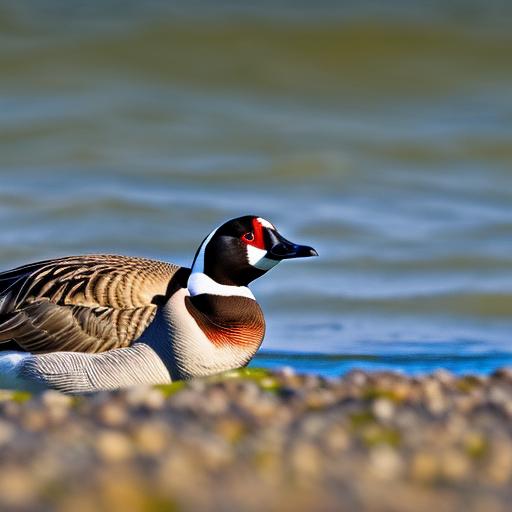Canadian geese are a common sight on beaches across Canada, but their presence can often cause problems for both beachgoers and the geese themselves. These large birds can be aggressive and territorial, posing a threat to people and pets. Additionally, their droppings can create unsightly and unsanitary conditions on the beach. It is important to find humane solutions to manage the geese population and minimize conflicts between humans and wildlife.
Key Takeaways
- Canadian geese are attracted to beaches due to the availability of food and water
- Physical barriers such as fencing and netting can prevent geese from accessing beaches
- Scare tactics such as loud noises and visual disturbances can deter geese from settling on beaches
- Maintaining a clean beach environment by removing food waste and debris can discourage geese from staying
- Natural repellents such as grape extract and predator urine can be effective in keeping geese away from beaches
Understanding the behavior of Canadian geese
To effectively manage the geese population on beaches, it is important to understand their behavior and what attracts them to these areas. Canadian geese are attracted to beaches because they provide open spaces for nesting and feeding. They prefer areas with short grass, access to water, and minimal human disturbance. Understanding their nesting and feeding habits can help in developing strategies to deter them from beaches.
Canadian geese typically nest near water bodies, such as lakes or ponds, but they have also adapted to nesting on beaches. They build nests on the ground using grasses and other vegetation, usually near water sources. Once the goslings hatch, the parents will lead them to nearby feeding areas, which often include grassy areas near the beach.
Implementing physical barriers on beaches
One effective strategy for managing Canadian geese on beaches is the implementation of physical barriers. Fencing or netting can be installed around beach areas to prevent geese from accessing these spaces. These barriers should be properly installed and regularly maintained to ensure their effectiveness.
Fencing should be at least three feet high and have small mesh openings to prevent geese from squeezing through. Netting can be used to cover large areas, such as sand dunes or grassy patches, where geese may be attracted to nest or feed. It is important to regularly inspect these barriers for any damage or gaps that may allow geese to enter.
Utilizing scare tactics to deter geese
Scare tactics can be an effective way to deter Canadian geese from beaches. There are various scare tactics that can be used, such as decoys or noise makers. Decoys, such as plastic owls or coyotes, can be placed in areas where geese are likely to gather. These decoys create the illusion of a predator and can scare the geese away.
Noise makers, such as air horns or whistles, can also be used to startle and deter geese. These noise makers should be rotated regularly to prevent habituation, as geese may become accustomed to certain sounds over time. It is important to use scare tactics in combination with other strategies for maximum effectiveness.
Maintaining a clean beach environment
Litter and food waste left on the beach can attract Canadian geese. They are opportunistic feeders and will consume anything that is readily available. To minimize the presence of geese on beaches, it is important to maintain a clean environment by regularly cleaning up litter and properly disposing of trash.
Beachgoers should be encouraged to clean up after themselves and dispose of their trash in designated bins. Regular beach clean-ups should also be organized to remove any litter that may have been left behind. By keeping the beach clean, the attraction for geese will be reduced.
Using natural repellents to keep geese away

Natural repellents can be used to deter Canadian geese from beaches. Grape extract is a commonly used natural repellent that can be sprayed on grassy areas where geese may be attracted to feed. The strong smell of the grape extract is unpleasant for the geese and will discourage them from staying in those areas.
Predator urine, such as coyote or fox urine, can also be used as a natural repellent. The scent of predator urine signals danger to the geese and will make them feel unsafe. These natural repellents should be applied regularly and after rain to maintain their effectiveness.
Establishing designated feeding areas for geese
One strategy to reduce the presence of Canadian geese on beaches is to establish designated feeding areas for them. These areas can be located away from the main beach area and should be properly maintained to ensure a consistent food source for the geese.
Designated feeding areas can be created by planting specific grasses or vegetation that are attractive to geese. These areas should be regularly monitored to prevent overfeeding and to ensure that the geese are not becoming dependent on human-provided food.
Educating beachgoers on geese interactions
Educating beachgoers on how to interact with Canadian geese is an important aspect of managing their presence on beaches. Human behavior can either attract or deter geese, so it is important for people to understand how their actions can impact the geese population.
Beachgoers should be educated on the importance of not feeding the geese, as this can lead to dependency and aggressive behavior. They should also be encouraged to keep a safe distance from the geese and not approach them or their nests. By educating beachgoers, conflicts between humans and geese can be minimized.
Seeking professional wildlife management assistance
In some cases, it may be necessary to seek professional wildlife management assistance to effectively manage the geese population on beaches. Professional wildlife managers have the knowledge and experience to develop and implement humane and effective strategies for geese control.
Professional assistance may be needed if other strategies have been unsuccessful or if the geese population is causing significant problems for beachgoers. It is important to find solutions that are both humane and effective in managing the geese population.
Creating noise and visual disturbances to deter geese
Creating noise and visual disturbances can be an effective way to deter Canadian geese from beaches. This can be done by using devices such as propane cannons, lasers, or reflective tape. These methods create a sense of danger and discomfort for the geese, causing them to seek out quieter and safer areas.
It is important to use non-harmful methods when creating noise and visual disturbances. These methods should not cause harm to the geese or other wildlife in the area. Additionally, these tactics should be rotated regularly to prevent habituation.
Implementing a combination of strategies for effective geese control
To effectively manage the geese population on beaches, it is often necessary to implement a combination of strategies. Combining physical barriers, scare tactics, maintaining a clean environment, using natural repellents, establishing designated feeding areas, educating beachgoers, seeking professional assistance, and creating noise and visual disturbances can create a comprehensive approach to geese control.
Each beach may require a different combination of strategies depending on its specific circumstances. It is important to assess the situation and determine which strategies will be most effective in managing the geese population.
Managing Canadian geese on beaches requires a humane and effective approach that considers both the needs of humans and wildlife. By understanding the behavior of geese and implementing strategies such as physical barriers, scare tactics, maintaining a clean environment, using natural repellents, establishing designated feeding areas, educating beachgoers, seeking professional assistance, and creating noise and visual disturbances, conflicts between humans and geese can be minimized. It is important to find solutions that work for both humans and geese to ensure a harmonious coexistence on our beaches.
If you’re looking for effective ways to keep Canadian geese off of beaches, you might find this article on Poultry Wizard quite helpful. It provides valuable insights and strategies on how to deter these birds from invading beach areas. From understanding their behavior patterns to implementing non-harmful deterrents, this article offers practical solutions for maintaining a goose-free beach environment. Check it out here for some expert advice on protecting your beach from unwanted feathered visitors.
FAQs
What are Canadian geese?
Canadian geese are a species of waterfowl that are native to North America. They are known for their distinctive black heads and necks, white cheeks, and brown bodies.
Why do Canadian geese go to beaches?
Canadian geese are attracted to beaches because they provide easy access to water and food sources such as grass and insects. They also provide a safe place for geese to rest and raise their young.
What problems do Canadian geese cause on beaches?
Canadian geese can cause a number of problems on beaches, including leaving behind large amounts of droppings that can be unsightly and unsanitary. They can also be aggressive towards humans and other animals, and their presence can disrupt other wildlife.
What are some methods for keeping Canadian geese off of beaches?
There are several methods for keeping Canadian geese off of beaches, including using decoys, installing fencing or netting, using noise deterrents, and using trained dogs to scare the geese away. It is important to note that some methods may be more effective than others depending on the specific situation.
Is it legal to harm or kill Canadian geese?
No, it is not legal to harm or kill Canadian geese without a permit. Canadian geese are protected under the Migratory Bird Treaty Act, which makes it illegal to harm or kill them without a permit from the U.S. Fish and Wildlife Service.
Meet Walter, the feathered-friend fanatic of Florida! Nestled in the sunshine state, Walter struts through life with his feathered companions, clucking his way to happiness. With a coop that’s fancier than a five-star hotel, he’s the Don Juan of the chicken world. When he’s not teaching his hens to do the cha-cha, you’ll find him in a heated debate with his prized rooster, Sir Clucks-a-Lot. Walter’s poultry passion is no yolk; he’s the sunny-side-up guy you never knew you needed in your flock of friends!







